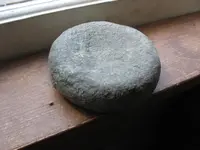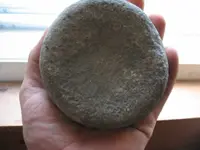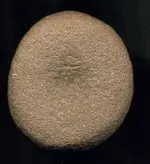Paul, hammerstones are round, like a small stone tennis ball. They are round like that (hammerstones), to make it easier to move them around and find new striking surfaces. Notice the large concave sides on that piece, typical disc....although still in manufacturing stages. I'm wondering if the pieces you are finding with the divets on the sides are what bell calls pitted manos or handstones? Bell's book is free online and I believe it shows a few of them in it (OAS website has it digitized I think). They are very common here, but aren't quite like a discoidal. Speaking of fitted (pitted) manos and nutting stones...I'm not at all convinced that they were used for nutting stones at all. After finding and examining a buttload of them, I'm starting to lean towards them being used for manufacturing something or other. Dunno...the questions are what makes it fun.
Hey, this reminds me..I will try to post a pic sometime in this century of a display that I think you'll get a kick out of. It's an educational display on how stone tool manufacturing over in Ark. I cast my son's hands knapping (using real hammerstones & pressure flaker) for the panorama.
Creek, It's not at all large for discoidal, I've seen them over 6" in diameter. There also are several different variants of discs throughout the country. They were used in a game called Chunkey (chung-ke).











